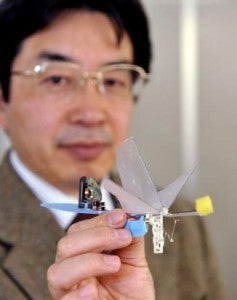The Remote Controlled Hummingbird Robot From Chiba (Video)

Share
Why just build robots in our own image, when there are millions of other animals to translate into machinery? The latest robot out of Chiba University in Japan can bob and weave like a hummingbird, and only weighs 2.6 grams (0.09 oz). Controlled via IR sensor, the robot can fly for about 6 minutes and up to 10 meters above the ground. Chiba's hummingbird bot is the brainchild of Professor H. Liu who plans on getting it to hover directly in place (just like it's namesake) very soon. While the robot only contains a micromotor, carbon fiber frame, and plastic wings for now, Liu wants to include a microcamera by 2011. This addition will allows the device to carry out search missions during emergencies. Check out the video from Diagonal Views below to see how Chiba's hummingbird is a cool example of how engineers are learning from biology to create some amazing new robots.
We've seen plenty of animal inspired bots climbing walls, skittering on floors, and jumping off buildings. There's even a competing robotic hummingbird project funded by DARPA in the US. Chiba University is at the lead of the trend, however, by getting its robot to fly unaided, even if just for a few minutes at a time. They've also pushed the envelope on getting the robot to be lightweight (2.6 grams is much less mass than the US version). However, I think they need to go back to the drawing board when it comes to naming the little bot. With four wings, I'm pretty sure this thing is more like a dragonfly than a hummingbird. In any case it's cool to watch in action.
Be Part of the Future
Sign up to receive top stories about groundbreaking technologies and visionary thinkers from SingularityHub.


Biomimetics (aka biomimicry) is a powerful tool for getting robots to exceed at tasks that living creatures have already conquered. I wonder though, if the future lies in robots that mimic life or in life that is infused with robotics. We've seen how cyborg insects have been outfitted with electronic controls to serve as spies. It will be interesting to see which project can field an autonomous flying platform with a camera first. Either way you should expect to see tiny eyes take to the skies fairly soon. After all, machines and biology may be learning to work together, but it's still human curiosity that is deciding what that work will be.
[image credit: Washington Times]
Related Articles

New Immune Treatment May Suppress HIV—No Daily Pills Required

Scientists Just Developed a Lasting Vaccine to Prevent Deadly Allergic Reactions

One Dose of This Gene Editor Could Defeat a Host of Genetic Diseases Suffered by Millions
What we’re reading
